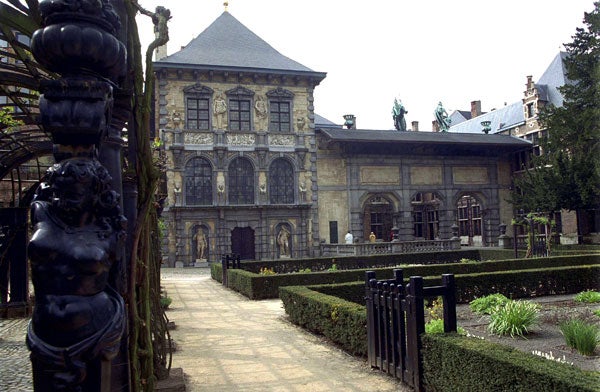Journey to the source: Fine art in Flanders
A visit to Antwerp is a chance to catch up on centuries of artistic endeavour.

Early 16th-century Antwerp was the new artistic hub of the Low Countries, having taken over from Bruges, which had flourished during the previous century with Jan van Eyck and later Hans Memling. One of the artists working in Antwerp at this time was Jan Gossaert, registered in 1503 as a master of the town's renowned Guild of St Luke for painters. Gossaert played a crucial role in the development of Netherlandish painting, and this week the National Gallery in London opened an exhibition devoted to him.
So what was Gossaert's Antwerp like? A map of the city printed in 1565, when the town's population was about 100,000, is now on display at the Plantin-Moretus museum. It shows a street layout almost identical to that of today. The museum, which is on Unesco's World Heritage list, celebrates Christopher Plantin and Jan Moretus. They were the 16th-century printers who took advantage of Antwerp's trading and cultural boom and helped turn it into one of three capitals for European typography (along with Venice and Paris).
The museum's treasures range from the world's two oldest surviving printing presses to a library including a Gutenberg bible and Antwerp Polyglot Bible, book illustrations by Peter Paul Rubens and drawings by Gossaert himself.
While we know that Gossaert was active in Antwerp, and most probably in nearby Mechelen, it is arguably his trip to Rome in 1508-09 that had the greatest influence on the development of painting. Travelling in the entourage of his patron Philip of Burgundy, Gossaert was one of the first northern artists to travel to Italy and experience first-hand the ancient and Renaissance works there. The drawings he made during the trip influenced his own and others' works, introducing the Italian Renaissance into the art of the Low Countries. As the National Gallery puts it: "Gossaert changed the course of Flemish art, going beyond the tradition of Jan van Eyck and charting new territory that eventually led to the great age of Rubens."
Rubens, active about a century later, is the artist most often associated with Antwerp. The Rubens House museum is largely a reconstruction of the artist's home, but in the peaceful gardens at the back are two original elements – the garden screen and pavilion. Inside, the house is filled with paintings, including several by Rubens. Of particular note is the museum's Art Room, which reopened earlier this month following restoration work.
Another place to admire Rubens masterpieces is Antwerp's cathedral, completed in 1521 and believed to be where Gossaert was buried. In addition to the Descent from the Cross and Raising of the Cross, visitors to the cathedral can also enjoy several Rubens altarpieces that have been reunited with their original home as a result of the temporary closure of the Royal Museum of Fine Arts Antwerp.
Fortunately, there are plenty of other places to enjoy art in Antwerp – not least the often overlooked Museum Mayer van den Bergh, just round the corner from the Rubens House (a combined ticket is available). The museum's collection was amassed during the second half of the 19th century by one man: Fritz Mayer van den Bergh. A highlight is Dulle Griet, or "Mad Meg" from 1562, by Pieter Bruegel the Elder. It's a painting crammed with disturbing scenes and characters evoking hell, in a style reminiscent of Hieronymus Bosch.
Mayer van den Bergh picked the work up at a Cologne auction for about 500 francs, the same year Antwerp's Royal Museum of Fine Arts bought Rubens' Prodigal Son for approximately 45,000 francs.
The museum, next door to where Mayer van den Bergh lived all his life houses one Gossaert work, his Lady Portrayed as Mary Magdalene. In addition to paintings, the collection encompasses an array of objects including tapestries, carved ivories and alabaster figures, and its collection of sculptures is the second most important in Belgium, after that of the Royal Museums of Art and History in Brussels.
And now the art of Antwerp has come full circle. Just north of Antwerp's historic centre, on the banks of the River Scheldt, is the striking new MAS (Museum aan de Stroom), which will open its doors in May but where you can already get a preview of the stories, objects and collections to go on display. The museum describes itself as a place to discover "how Antwerp and the world have been indisputably linked with one another for years". Its first temporary exhibition will showcase 50 works from the fine arts museum.
Jan Gossaert's Renaissance at the National Gallery (0844 847 2409; nationalgallery.org.uk) runs to 30 May, admission £11.
Travel essentials: Flanders
Getting there
* Eurostar offers services from London to Brussels, with connecting trains to Antwerp from £80 (08432 186 186; eurostar.com).
Visiting there
* Museum Plantin-Moretus (00 32 3 221 1450; museum. antwerpen.be) Vrijdagmarkt 22. Admission €6 per adult.
* De Kathedraal (00 32 3 213 9951; dekathedraal.be) Groenplaats 21. Admission €5 per adult.
* Museum Mayer van den Bergh (00 32 3 232 4237; museum.antwerpen.be) Lange Gasthuisstraat 19. Admission €4.
* The Rubens House (00 32 3 201 1555; antwerpen.be) Wapper 9-11. Admission €6.
* MAS (00 32 3 338 4434; mas.be) Hanzestedenplaats 1, Antwerp. Open from 17 May 2011; admission to the permanent collection €5.
More information
* visitflanders.co.uk
Subscribe to Independent Premium to bookmark this article
Want to bookmark your favourite articles and stories to read or reference later? Start your Independent Premium subscription today.

Join our commenting forum
Join thought-provoking conversations, follow other Independent readers and see their replies